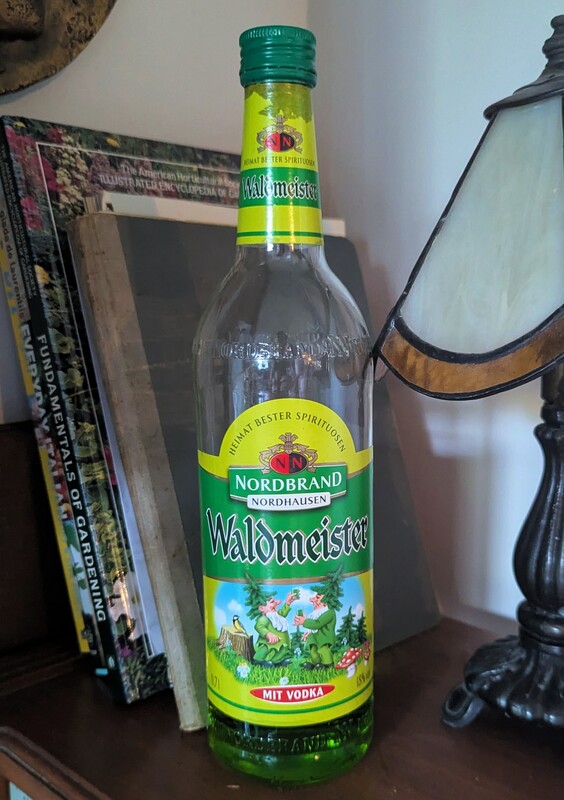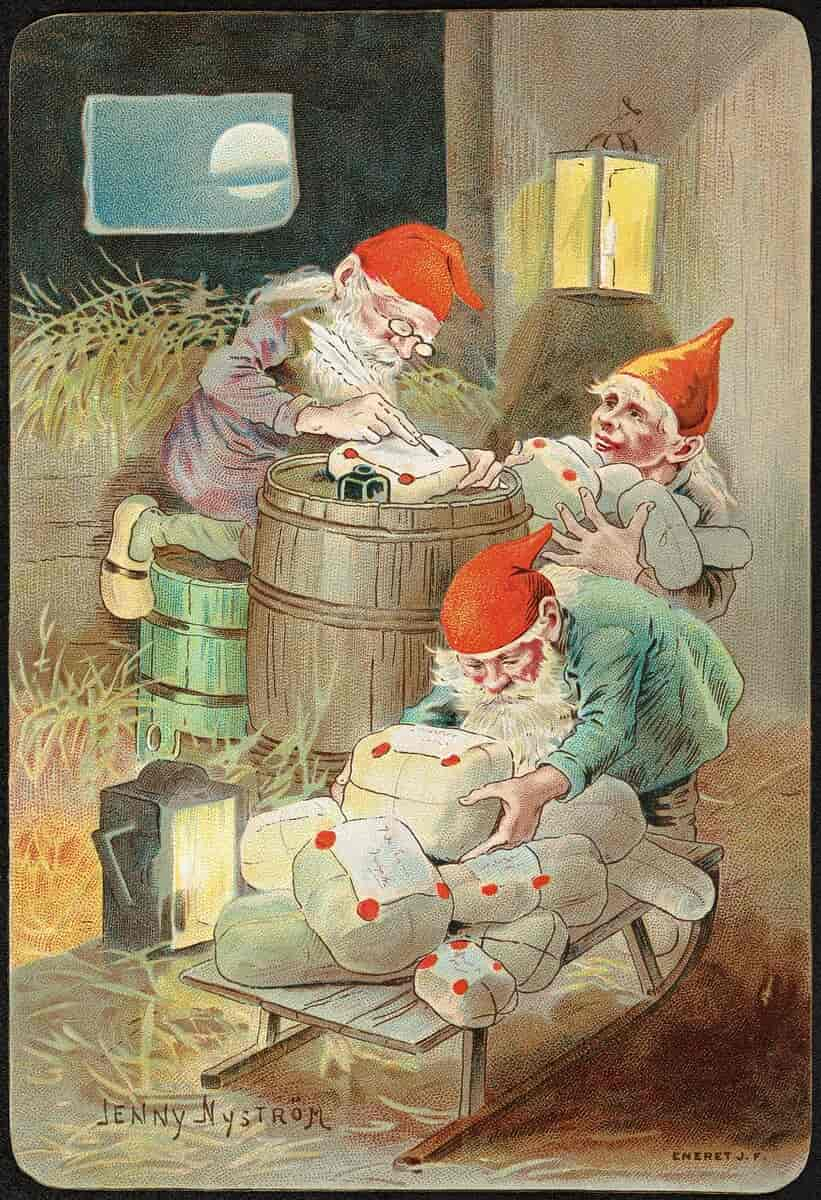|
The Plant That’s Been Charming Drunks and Undertakers Since Medieval times... There’s a fun woodland weed that you might want to know about. It's an unassuming little plant, with dainty white flowers and whorled leaves. However, it has been sneaking its way into drinks, pagan rituals, and your strange aunt’s potpourri for centuries, maybe even thousands of years. So, let’s unpack some of the sweet and sinister history of sweet woodruff (galium odoratum). A History Drenched in Death and Decay? Remember the good old Middle Ages? Life in Europe was an unpleasant parade of plagues, wars executions, rampant werewolfery (see a previous blog on a more recent case of wolfy mayhem) and no indoor plumbing. Growing all over the shadowy forests of Europe, this herb was the medieval undertaker’s best friend. It's interesting, vanilla hay-like scent—think ice cream that had been kissed by a recently fed guinea pig—made it perfect for stuffing into coffins or strewing over plague-ridden floors to mask the putrid stench of our ultimate mortality. It’s possible that it may have even been used to ward off those pesky evil spirits that seemed to be everywhere at the time, or at least help make them smell a bit less grave-y. By the Renaissance, woodruff was common in apothecary shops and brewed into teas to cure insomnia and melancholia or to more generally, “rebalance the humours”. Before you run outside and eat a bushel to help get over whatever disorder you’ve decided that you now suffer from because of tiktok videos, though, keep in mind that large quantities of coumarin (i.e., the most interesting and tasty part of the plant) could really mess with your liver. Moderation is the name of the game with this wee plant beastie. Fast forward to the 19th century, and this herb was slinking into aristocratic punch bowls, it’s probably most famous in May wine (Maibowle in German), Germany’s famous springtime punch consists of steeping sweet woodruff in white wine with strawberries. Woodruff’s strange, but pleasant flavor is the epitome of the transition from Spring to Summer. Sweet woodruff (aka waldmeister) is prized in German beer as well. It’s very popular to add waldmeister syrup (see recipe below) to Berliner Weisse beer. The latter is a low-horsepower wheat beer primarily associated with Berlin, known for its crisp, effervescence and pleasant sourness. Waldmeister syrup, with its soft flavor, perfectly balances out its tartness. However, be warned that artificial green colors are often added for dramatic effect. Craft distillers, those alcohol alchemists who pepper the countryside of every civilized locale these days, sneak woodruff into schnapps or liqueurs to elevate the exotic flair. Want to play hipster bartender yourself? Simple infuse woodruff into vodka with some (natural) red grenadine or black walnut bitters for a cocktail ingredient that screams gothic pretension. Just filter out the leaves unless you want your glass looking like a witch’s compost pile. How to Summon the Woodruff Fairies:
Woodruff is not easy. Its flavor isn’t ready made; it takes some coaxing to emerge. It’s best to harvest this herb on a misty morning in early June (like today, June 3, 2025), when it’s blooming. Snip stems with scissors so you don’t damage the plant too much and dry them for a day or so to allow the coumarin’s flavor to emerge and intensify. Please don’t skip this step unless you want a bland flavor and only the ghost of a vanilla aroma. Now, get rid of those stems, keeping only the slightly shriveled leaves. Boil up some simple syrup. When it’s made, take it off the heat, throw in some lemon slices for flavor (and to cool down the syrup a bit), and then add the woodruff. Once it cools to room temperature, cover and refrigerate for 1-2 days, strain, bottle, and store. You now have the makings of a great flavoring for beer, cakes, or craft cocktails. Sweet Woodruff Simple Syrup Recipe Ingredients: - 1 cup water - 1 cup granulated sugar - 2/3 cup fresh sweet woodruff leaves (washed and dried for 1-2 days) 1. Combine Ingredients: In a small saucepan, combine water and sugar. Stir over medium heat until the sugar dissolves completely. 2. Remove from the saucepan. Add the lemon slices 3. Add the dried sweet woodruff leaves to the saucepan. 4. Let the syrup cool to room temperature. Now, cover and refrigerate for 1-2 days. 5. Last, but not least, strain through a fine mesh sieve or cheesecloth to remove the leaves. Pour the syrup into a clean, airtight bottle or jar. Store in the refrigerator. Tips: - This syrup is great in cocktails, mocktails, lemonades, or even drizzled over desserts. - Ensure sweet woodruff is sourced safely, as it should be used in moderation due to its coumarin content.
0 Comments
When you next visit (or first visit) Spain, might we make a humble suggestion? As you’re ordering your fancy paella or ham (i.e., jamon iberico) – worrying about whether or not the waiter will understand your mangling of the Spanish language – make sure you don’t get too anxious and forget to order a glass of vermut. This is not a misspelling, but the way those clever Spaniards spell the more well-known ‘vermouth’ of French and Italian fame. “But isn’t that more of a mixer for a Manhattan or a martini?” you might ask. In the case of French or Italian vermouth, you would be correct, but not so for vermut. We discovered this purely by chance. We had planned to try some of the more unusual drinks that the East Coast of Spain had to offer. Our list included Mistella (i.e., a sweet muscat wine where the inclusion of alcohol is used to stop fermentation and keep the natural sugars available) and Frigola de Tomillo (i.e., a liqueur with dominant flavors of thyme, of all things). We found neither of these tipples in the first bar we went into, but lots of signs for vermut. When in doubt, follow the locals, and our conception of vermouth was forever changed. How is Spanish vermut different from French and Italian vermouths? We enjoy regular vermouth, and always keep at least two bottles in the fridge. However, we primarily use it in cocktails. Vermut, on the other hand, is rarely mixed, and is much easier to drink. We’ve heard that the Spanish have a philosophy of “a little bit, a lot of time”. This goes not only for tapas, but for vermut as well. It’s not uncommon to slowly drink a glass here, a glass there, as you meander your way through several local tapas bars. This would probably be more difficult with French or Italian vermouth. The Spanish stuff is much more drinkable, but it’s hard to pick out the reasons why. Both red vermouth and the many shades of Spanish vermut are sweet and have some nice herbal complexity, but there’s something about vermut that makes you want to imbibe more and more. Maybe it’s the freshness of the herbs or the fact that some manufacturers only use grape sugar for sweetness, but this is a special drink we could (and did) drink all day - very slowly, of course.
The Composition of Vermouth As with most boozes, there are some rules you have to follow to warrant a name. Vermouths and vermuts must:
Other than these rules, the sky’s the limit. The Spanish varieties are uniformly sweet (i.e., semi- sweet to dessert-y sweet). They are also very herbal-y. The white ones, being more delicate, are flavored with flowers, herbs, and anise whereas reds give up bolder flavors of roots and seeds. One varietal we had mixed gentian root to augment the wormwood bitterness. Vermut also comes in three broad colors: white, orange, and red. While hiking around a castle one day, we found little café that served all three (!!!). Our server looked at us very strangely when we ordered the full menu, but we did get to do an impromptu tasting while looking at the historical scenery. How to enjoy
Note: In part II of this series, we will describe a tour to one of the most famous producers of Spanish vermut. Imagine that you’ve been transported back to 1970. It would look both strangely similar and different from today. You certainly wouldn’t be seeing cell phones or cybertrucks, but you would see still people wearing bell-bottoms, pornstar moustaches, and feathered hair (but all unironically back then). If you turned on the radio, you’d hear I’ll be There by The Jackson Five, Layla by Derek and the Dominos, and Lola by The Kinks, not on an oldies station, but on the American Top 40 hosted by Casey Kasem (which also started this same year). Now picture yourself parked in a nice car in a remote location in the woods outside of Washington, DC. It's almost Halloween, and you and your main squeeze are parked right next to a small bridge. It’s very dark. Your car engine is running, maybe to keep the car warm enough for any disco-era shenanigans you have planned, or maybe – and more innocently – you just want to keep the radio on so you can hear that wild new song by The Carpenters. It seems like a nice night regardless. But alas, your sexy 70's tranquility is then traumatically disturbed. You can’t believe your eyes. Are you losing your mind? Out of the darkness, you both see a grown man wearing a bunny suit. They guy is hopping mad (see what I did there?), literally frothing at the mouth in anger, and screaming at you. As he gets closer you can make out the word “trespassing” in his unhinged tirade, but little else. Then, as if he was a dwarf from Lord of the Rings, he lobs an axe through your window, shattering it into a million shards. Terrified, you jam on the accelerator and bolt out of there as quickly as your non-unleaded gas can take you. You've just met the Bunny Man. Before the internet, stories like this might stay purely regional. It would be far more difficult for “Slender Man” and other tales to grab hold of the public consciousness without online forums. Back in the 1970s, strange stories like this got passed along and elaborated upon through word of mouth, some eventually becoming “urban legends”. Not surprisingly, there quickly became several variations of "The Bunny Man" bandied about at teenage sleepovers or to help pass the time in junior high Algebra classes. He became even more threatening as time went. Just a few years later, hushed whispers – usually made across the teenage frequencies – gave him an origin story. The Bunny Man was now an escaped mental patient and psychopath. The gentleman was responsible for several deaths in the area, sometimes hanging them upside down from the bridge in similar fashion to what the Italians did to Benito Mussolini and his mistress at the end of World War II. Along with murder, The Bunny Man also was said to have a penchant for animal mutilation. Just heaving axes into car windows was just so 1970… We must say that this is a great story that one of us even heard while living on the other side of the country. It’s got just about everything a good urban legend needs and is, franky, just a lot of fun to think about.
But, as is well-known, skeptics and researchers generally take all the fun out of everything. Such is the case with this rascally rabbit. Most of the stories associated with the Bunny Man are apparently pure bunk. The only one with any truth to it is the introductory story. For those of you interested in a more reasonable, less fun take on the matter than the Bunny Man stringing up dead bodies all over Fairfax County, please read this: https://research.fairfaxcounty.gov/local-history/bunnyman However, if we’re being honest, we much prefer the legend. It's kind of fun to imagine that the Bunny Man is still out there, wearing a fur suit matted with the blood of his victims, fantasizing about all the delicious vengeance he'd like to mete out on those dastardly people who dared to trespass near his precious bridge. He may very well be sharpening his axe and giggling to himself as we type this paltry prose... Travel Tips: If you want to visit this easy to miss one lane bridge in Clifton VA, you would never guess how close you are to DC. For all of its association with malevolent ax-wielding tomfoolery, it’s a lovely place nestled between open fields, babbling brooks, and some pretty opulent mansions. It’s truly a beautiful area, but we could imagine it taking on more of a Blair Witch vibe at night.  Tomten love to take care of animals. Tomten love to take care of animals. You’ve all seen those Christmas gnomes. You know, the cute ones with chubby bodies, stubby little feet, long gray beards, and tall, festive wooly hats that stand straight up (i.e., as if Santa’s cap took Cialis). They’ve likely been on the shelves of your local department store since the very second that Halloween officially ended. You may have already purchased a few of them. They may be decorating your Christmas tree or children’s bedroom right now. Well, dear reader, we have some important information to impart... information that might save you and your pets' lives. There are a few things you need to know about these guys. What are they? First off, they're not technically gnomes. They sure do look like them at first glance, but as any nerd who misspent large portions of their youth reading fantasy novels or the works of the Swiss physician Paracelsus knows, gnomes typically live underground and guard treasure. Gnomes, these are not. These little bundles of Christmas cheer are actually called Tomten (singular = tomte). They are nisse in Danish and tonttu in Finnish. At one point in time, so the story goes, they were normal-sized humans just like us. Farming was their gig. Many stories tell of their being the original owner of a nice homestead, caring for their land until death. After they shuffled off their mortal coil, they somehow gained immortality, shrank a bit, and decided to stick around the farm. They’re kind of like miniature household deities. However, it would appear that one downside of a tomten’s eternal life is that they are forced to buy their hats exclusively from one very deranged haberdashery. There’s always a catch to immortality… What do they do? Tomten can be very helpful. Stories abound of them doing chores for the new owners and taking good care of animals. They legitimately care about their farm and want to help keep it running smoothly regardless of who owns it. Thus, they don’t behave much differently from any other good Swedish farmer. As you all know, Swedes are a diligent bunch, so these immortal ones are handy to have around. What do they like? Tomten generally like to work hard, be left alone, and be shown respect. Thus, if you accidentally spill a drink on the floor, you should apologize to any tomten who might be working below you. Apart from respect, tomten don’t need much in compensation for all their hard work. Unlike gnomes, they’re fairly uninterested in money or other fancy things. But, again, everything comes with a cost. So, if you want to truly keep your tomte happy, you can’t forget one important rule: make sure to give them porridge on Christmas eve with a pat of butter on top. Tomten are greedy for butter. They love the stuff as much as Golem loves The Precious. However, they apparently only need their #1 vice one day out of the entire year (don’t ask us why – we didn’t come up with this shit). Therefore, you would be wise to comply with this humble request, making sure to have a single bowl of porridge laid out for your squat friend every Christmas eve. Also, keep in mind that tomten are a bit like Mogwai from Gremlins movies: bad things can happen if you don’t follow instructions. We will type this again in bold: bad things can happen if you don’t follow instructions. Always please put the pat of butter ON TOP of the porridge. If you don't, you could make them angry. What happens when they get angry? One story tells of a work-weary tomten who stopped by the house after everyone went to bed to enjoy his Christmas Eve repast. Looking down at the bowl of porridge, there was no butter. The audacity! The insult! A year’s worth of hard work and the stingy farmer can’t even spare one little dab of creamy goodness?!?! The tomten understandably flew off the handle. Red with anger, he ran out of the kitchen as fast as his stubby legs could carry him – his long beard blowing in the wind like he was in a diminutive Victoria’s Secret photo shoot. He threw open the barn door and entered. He stood at the door a moment in silence, his moonlit shadow much larger than his childlike frame would imply. Tension hung thickly in the air, and every single animal in the barn held its breath. Then, in a fit of blind, butter-induced rage, he killed the first cow he saw, blood spurting onto his red felt cap and bits of gore lodging into his long gray beard. When it was over, the tomte noticed rivulets of crimson melting the snow outside the barn. Righteous vengeance was his. Boathrocide isn’t easy work, though, so after he calmed down, he realized that he was still a hungry little tomte. He then walked back to the kitchen, leaving a trail of bloody little footprints in the snow, and tucked into his seemingly bland porridge. Then, he made a startling discovery… there WAS butter, but it was at the bottom of the bowl! Oceans of dairy-induced remorse overtook the tomten, and he bolted out the house again. The penitent little livestock slayer ran to the neighbor’s barn this time, quickly stealing a of cow to replace the murdered one. This tale doesn’t reveal whether or not the farmer noticed that he had a purloined heiffer in his barn, but who cares? The scales of tomten justice were righted nonetheless (except for the neighbor – tomten morality can be a bit fuzzy sometimes). Conclusions
Before deciding if tomten are right for you, consider the details we mentioned above. Though they are cute, remember that they are not ornaments. They can be helpful additions to any family, but they must be paid the buttery respect they deserve. And, before you ask, margarine is not an acceptable substitute. Don’t even try to give them any of that boujee whipped stuff either. Do you want your pets to die?!?! Disrespect can have consequences. Caveat Emptor, indeed… Happy (and safe) holidays from the PD team! Travel Notes: Tomten don’t seem to be associated with any particular part of Sweden. They instead seem to be generally Scandinavian. You can find authentic Swedish tomten at various stores. We purchased our very first tomte (named Ost) at a Maxi ICA Stormarknad (i.e., supermarket) outside of Uppsala, Sweden. We should also say that Ost was not very amenable to being on a plane, so we thank the old gods that we remembered to bring extra pats of butter in our carryon luggage. Even Samuel L. Jackson couldn’t have saved us from Tomten on a Plane. |
Categories
All
Archives
June 2025
|

















 RSS Feed
RSS Feed